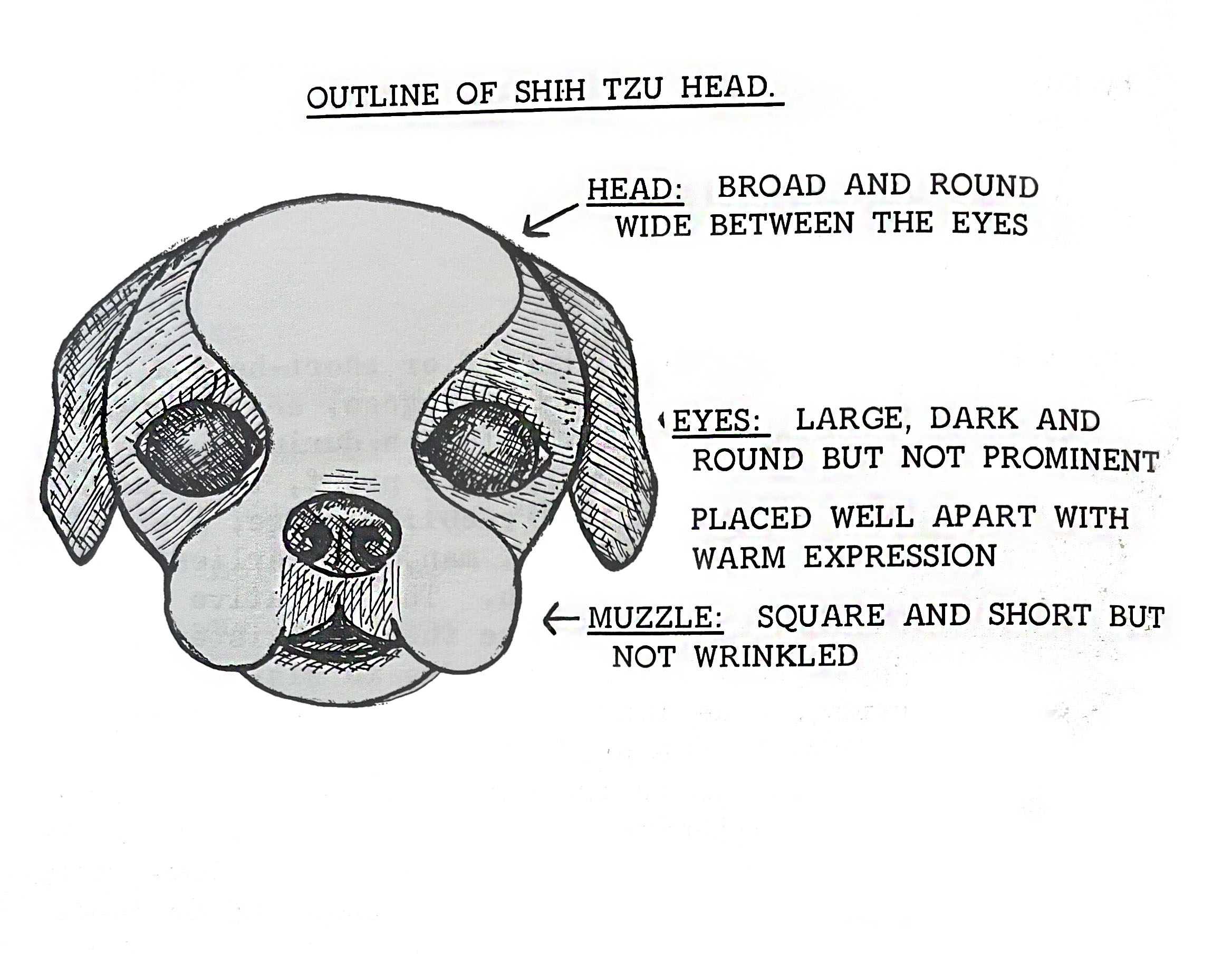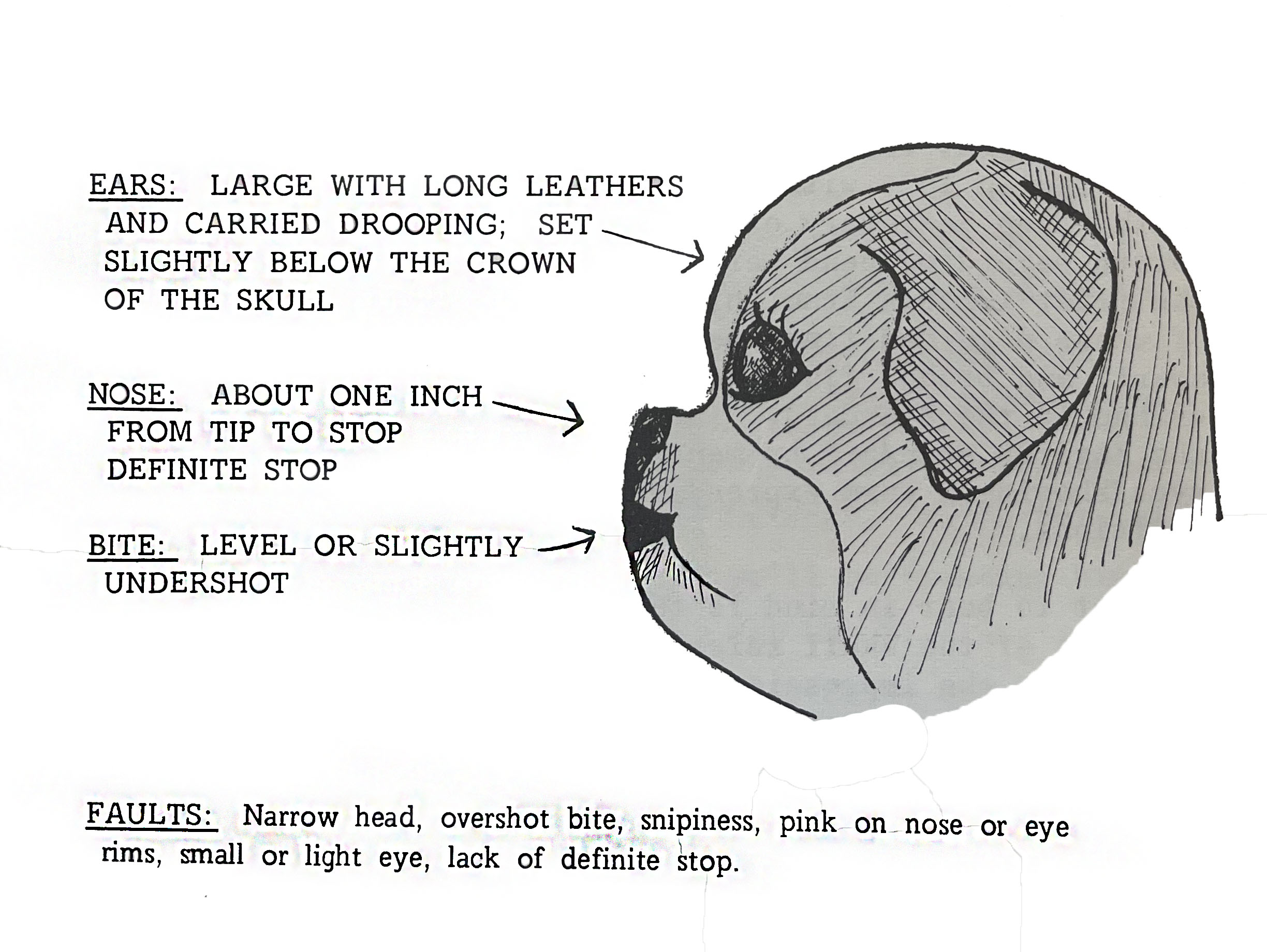The Shih Tzu Head
By Gay Widdrington, Lhakang Kennels, England
The Shih Tzu has the BRACHYCEPHALIC or short-headed type of skull, also seen in the Pug and Pekingese, and this skull first came into existence as a mutation during the dawn of history. Though there is no definite proof, this mutation may have occurred in the Early Paleolithic age, over 70,000 years ago when Neanderthal man, the earliest member of Homo Sapiens, roamed the earth. The causative factors which produced such mutations were then in existence in the form of geological radiations, due to disturbances in the earth’s crust. The lands in the Chinese zone were particularly given to the production of the short-headed skull. These mutations in the canine world would undoubtedly not have survived (being unable to kill their prey) had not primitive man been willing to domesticate them, using them possibly as bed-warmers, as watch-dogs, and as food.
To come to modern times, the original standard in the Western world was written out by General Sir Douglas Brownrigg in 1934 with the helpful advice of Mr. A. Croxton-Smith, then Secretary of the English Kennel Club, and the points regarding head were based on the head structure of the first imports from China and their offspring. The best of these dogs had fine massive skulls, large eyes set well apart, and broad, flat, well-padded muzzles as still described in the standard. The American standard amplifies the English standard by mentioning a “definite stop” and eyes “showing a warm expression,” which are very welcome additions.
A point to bear in mind is that the description of the proportions of the skull refers to the actual head structure and not to the impression given by the long profuse hair. A good head construction can clearly be seen when a puppy is about a month old, before the coat has fluffed out. A good time to examine the skull is when the dog is wet from a bath, and sometimes it can be seen that the proportions are disappointing--the skull can be too narrow, the eyes too small and close, and the muzzle too pinched.


A GOOD HEAD MAKES A CHARMING DOG WITH A MOST APPEALING EXPRESSION
The following are a few details not mentioned in the standard:
The drawings are taken from measurements of dogs with good heads as described in the standard, and the parti-colour markings are drawn in to help with the general effect.
CREDIT: From the September 1972 Shih Tzu Bulletin. This article, written in the early days of breed recognition, describes the healthy Shih Tzu head, a complex collection of recessives that needs to be preserved for the health of the breed. A head that is made to look correct by grooming is not correct. What is described here is the head long-time breeder judges and breeders say we are losing.
The Shih Tzu has the BRACHYCEPHALIC or short-headed type of skull, also seen in the Pug and Pekingese, and this skull first came into existence as a mutation during the dawn of history. Though there is no definite proof, this mutation may have occurred in the Early Paleolithic age, over 70,000 years ago when Neanderthal man, the earliest member of Homo Sapiens, roamed the earth. The causative factors which produced such mutations were then in existence in the form of geological radiations, due to disturbances in the earth’s crust. The lands in the Chinese zone were particularly given to the production of the short-headed skull. These mutations in the canine world would undoubtedly not have survived (being unable to kill their prey) had not primitive man been willing to domesticate them, using them possibly as bed-warmers, as watch-dogs, and as food.
To come to modern times, the original standard in the Western world was written out by General Sir Douglas Brownrigg in 1934 with the helpful advice of Mr. A. Croxton-Smith, then Secretary of the English Kennel Club, and the points regarding head were based on the head structure of the first imports from China and their offspring. The best of these dogs had fine massive skulls, large eyes set well apart, and broad, flat, well-padded muzzles as still described in the standard. The American standard amplifies the English standard by mentioning a “definite stop” and eyes “showing a warm expression,” which are very welcome additions.
A point to bear in mind is that the description of the proportions of the skull refers to the actual head structure and not to the impression given by the long profuse hair. A good head construction can clearly be seen when a puppy is about a month old, before the coat has fluffed out. A good time to examine the skull is when the dog is wet from a bath, and sometimes it can be seen that the proportions are disappointing--the skull can be too narrow, the eyes too small and close, and the muzzle too pinched.


A GOOD HEAD MAKES A CHARMING DOG WITH A MOST APPEALING EXPRESSION
The following are a few details not mentioned in the standard:
The skull should be broader from side to side than from front to back.
The brow should be noble and should not slope away too quickly behind the eyes.
The top rim of the nose leather should be on a line with, or slightly below the lower rim of the eyes.
The muzzle should be well-padded and there should be a strong chin.
Lips should be well-defined and black (or dark brown in liver dogs) and should look rather human.
The beautiful eyes should look straight into yours, and again should look rather human as they are frontally-placed in the skull and both can focus on the same object, unlike a narrow-headed breed whose eyes are further round the side of the head.
Nose-leather broad and nostrils well open.
The drawings are taken from measurements of dogs with good heads as described in the standard, and the parti-colour markings are drawn in to help with the general effect.
CREDIT: From the September 1972 Shih Tzu Bulletin. This article, written in the early days of breed recognition, describes the healthy Shih Tzu head, a complex collection of recessives that needs to be preserved for the health of the breed. A head that is made to look correct by grooming is not correct. What is described here is the head long-time breeder judges and breeders say we are losing.
